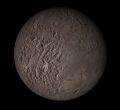Difference between revisions of "Caliban"
(Caliban.) Tag: Removed redirect |
(Caliban article.) |
||
| Line 61: | Line 61: | ||
<gallery> | <gallery> | ||
Caliban-uranuszip.jpg|<center>Caliban from ''uranus.zip'' in Orbiter 2002</center> | Caliban-uranuszip.jpg|<center>Caliban from ''uranus.zip'' in Orbiter 2002</center> | ||
| − | + | Caliban discovery Palomar.gif|<center>Caliban imaged by the [[w:Palomar Observatory|Palomar Observatory]] in 1997,<br>from Wikimedia Commons</center> | |
| + | Animation of Sycorax orbit around Uranus.gif|<center>Animation of the orbits of [[Caliban]], [[Francisco]], [[Stephano]], [[Sycorax]], and [[Trinculo]],<br>from Wikimedia Commons.</center> | ||
</gallery> | </gallery> | ||
Revision as of 12:51, 11 August 2024
Caliban (Uranus XVI, S/1997 U 1) is one of the outer satellites of Uranus. It orbits It was discovered by the Voyager2 spacecraft in January 1986. It is named after the sister of Katherine in Shakespeare's The Taming of the Shrew.
Caliban in Orbiter
Caliban was first introduced into Orbiter with the add-on uranus.zip in November 2002.
| Add-on | Source | Version | Author | Type | Release Date | Compatibility | Wiki article |
|---|---|---|---|---|---|---|---|
| Uranus | AVSIM | Rolf Keibel | Scenery | 5 November 2002 | |||
Caliban imaged by the Palomar Observatory in 1997,
from Wikimedia Commons
| Uranus's natural satellites |
|---|
| Named Satellites:
Ariel | Belinda | Bianca | Caliban | Cordelia | Cressida | Cupid | Desdemona | Ferdinand | Francisco | Juliet | Mab | Margaret | Miranda | Oberon | Ophelia | Perdita | Portia | Prospero | Puck | Rosalind | Setebos | Stephano | Sycorax | Titania | Trinculo | Umbriel Numbered Satellites: |
| See also: Pronunciation key | rings of Uranus |
| edit The Solar System | |
|---|---|
| Central star |
Sun (Sol) |
| Planets |
Mercury - Venus - Earth - Mars - Jupiter - Saturn - Uranus - Neptune |
| Natural satellites |
Moon - Phobos - Deimos - Io - Europa - Ganymede - Titan - more... |
| Add-ons |
Planets - Dwarf Planets - Small objects - Natural satellites - Alternative star systems |
 | This natural satellite related article is a stub. You can help Orbiterwiki by expanding it.
|



